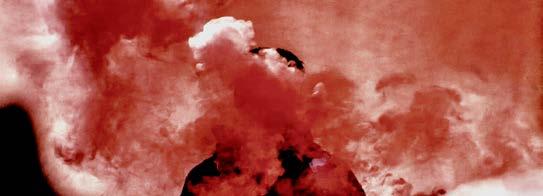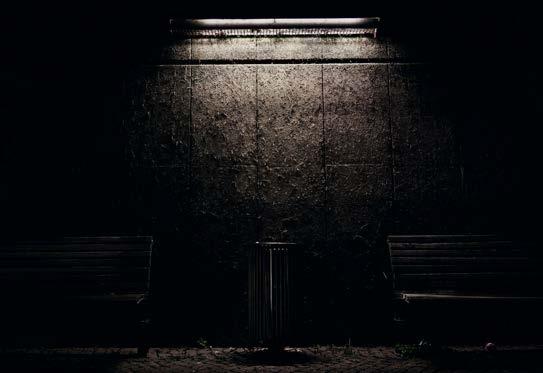
8 minute read
Deadly Class: Coming-of-Age as a Killer
Written by Vikram Nijhawan
Advertisement
Marcus Lopez Arguello’s monologue here reeks with teen angst, and would not be out of place in any high school-set bildungsroman. He could just as easily be Holden Caulfield, the protagonist of J.D. Salinger’s The Catcher in the Rye, relaying this jaded introspection. But the relevance of Marcus’ words is compounded by the setting he inhabits – not just any ordinary high school, but rather Kings Dominion Atelier of the Deadly Arts. In Rick Remender’s television series Deadly Class, adapted from the comic book series of the same name, this is where the children of the most powerful crime syndicates on earth train to enter their respective family businesses.
The milieu amplifies the usual growing pains of adolescents in the 1980s, by plunging them into a violent world at a formative age. The “masks” Marcus and his peers don are not merely to gain social acceptance, but also a necessity for survival. The academy’s cliques are organized by gang affiliation, and a normally benign schoolyard argument can take a deadly turn. Remender and his fellow showrunner, Miles Orion Feldsott, perfectly blend what would seem disparate genres, that of a coming-of-age story and a gritty crime drama. The fourth episode “Mirror People”, written by Feldsott, best exemplifies the mixture of these two worlds.
The Breakfast Club Meets Home Invasion
The episode begins with our cast of characters locked in “prolonged confinement designed for behavioural rectification” (“Mirror People”, 04:30-04:35), as Petra describes it – or in other words, detention. The episode’s underlying premise echoes one of the most iconic films of the era, The Breakfast Club, where ambivalent teens from different social strata bond over their collective situation. Feldsott makes good use of the intimate setting, forcing characters with previously established tension into a room together. Throughout the adventure, Marcus and Saya acknowledge their romantic feelings towards one another, while the school bully Chico is constantly butting heads with the others. This adolescent drama is complicated, however, by the looming threat of Yakuza assassins, coming to attack our main characters while they are most vulnerable. The conceptual foundation of this episode, combining the Breakfast Club homage with a home invasion thriller, represents the convergence of these two worlds – a story of high school growth and one of violent criminals – which each plot point embodies.
Feldsott balances the distinct tones of these two worlds in an effective and gripping manner. The early detention scenes are lighthearted and humorous, containing constant back-and-forth between the characters, timely pop culture references, and all-around camaraderie. Viktor’s inability to grasp the nuances of the film Robocop, and Marcus’ surprise at discovering Chico’s admiration for the song “In Between Days” by The Cure, all serve to humanize these killers in training. These moments of levity remind the audience that regardless of their unconventional family backgrounds, these students are fundamentally the same as any other teenagers. They too possess anxieties and doubts, and have opinions on all matters, ranging from the nature vs. nurture debate to the impact of climate change on future populations. In this way, the students of Kings Dominion share the same attitudes as youths living today. These little moments flesh out the characters, and allow the viewers to see them in a more casual environment, without the animosity and vicious competition encouraged by the school’s curriculum.

Juxtaposing these bonding scenes is the ominous arrival of the Kamiga Brothers. These formidable assassins create great suspense as they mow through the school guards with ease, slowly creeping towards the detention crew. The dramatic irony is palpable, as the audience knows the danger which awaits them while the characters remain oblivious. When the Kamigas finally do attack our main characters, at the episode’s mid-point, there is a noticeable shift in tone. The formerly intimate setting becomes increasingly claustrophobic as the teens are cornered by this antagonistic force. The chemistry between the characters is thrown out the window, made clear when Chico readily sacrifices Jaden’s life to ensure the rest of them escape. While Marcus berates him for this heartless decision soon after, Chico stresses it was purely a pragmatic move.
The Kamigas’ ambush, and the actions it inspires from the characters, is a harsh dose of reality for both them and the audience. By the end of the episode, the conflict has fractured the chemistry of our detention crew. Jaden is dead, Petra and Viktor are severely wounded, and Saya is traumatized by the death of her cousin. Marcus’ final inner monologue about the nature of life being suffering ties this tonal transition together. It states loudly and clearly that as much as these students may want to live normal teenage lives, luxuries such as friendship must be traded off in order to prosper in their cruel world, a sad truth which contrasts the flippant yet playful tone at the beginning.
Saya’s Journey
Saya Kuroki’s arc throughout “Mirror People” is a microcosm for the larger generic and tonal flux the series seeks to achieve. From the beginning, Feldsott highlights the girl’s attachment to her sword. She is irked when the school headmaster Lin confiscates it during her detention and spends the remainder of the episode searching for her cherished weapon, whilst being sequestered and evading her lethal cousins. The sword acts as a MacGuffin, an object whose pursuit drives the plot forward in a work of fiction. It prevents the episode from meandering, but Saya’s single-minded focus in retrieving the weapon also reveals a crucial and relatable aspect of her character. Amidst the cat-and-mouse game between them and the assassins, she tells Marcus that the sword once belonged to her father, and that it is her sole memento. This is why she invests a large portion of her identity into the weapon. Saya struggling to wrest the sword from the Kamigas is an external manifestation of her inner identity crisis. It symbolizes her insecurity, her fear that she will not live up to her late father’s expectations. Saya is not fighting to protect the sword itself, but rather to preserve her family’s honour. One of the essential milestones of any bildungsroman is the moment where the young character breaks away from their previous childhood identity, usually one connected to their family. This is a familiar experience for all teens, not just children of notorious Japanese gangsters.
When Saya finally kills her cousin and reclaims the sword, it leaves a visible emotional scar on her. In effect, this action is an externalization of her breaking away, and redefining her own identity. The next scene shows her confiding in Marcus on the school’s rooftop, solemnly contemplating the murder she just committed. After the intensity of the preceding fight scene, the tone reverts to that of a teen drama, which is exactly where the episode began. Saya’s confliction is a hallmark of the adolescent experience. If this were an average thriller, the screenwriter would not feel the need to follow up the high-octane action sequence with this melancholier reaction scene. Feldsott knows this is not just a crime drama, and that this scene is vital for depicting the unique hurdles along the path to growing up. It is evidence that while Kings Dominion grooms its pupils to be hardened killers, they are just as inhibited by uncertainty and confusion as any teenager.

Academy for the Damned
This paradoxical premise is what makes the world of Deadly Class so intriguing. Kings Dominion is not Hogwarts, a whimsical boarding school that millions of children dream of attending. None of the Atelier’s students are there by choice, but instead forced to be there by their circumstances. In spite of this, Marcus and his friends attempt to carve out an enjoyable adolescence, to live their “in between days” as best they can within their dreary surroundings. Remender and Feldsott portray these two clashing worlds alongside each other. These soon-to-be assassins still go to house parties and school dances, have relationship problems, and struggle to achieve good grades in their classes. They search for a glimmer of normalcy and joy while studying to take human life. The result is a raw, twisted, and ultimately authentic coming-of-age story. Marcus aptly summarizes the series’ core theme at the end of the pilot episode: “Maybe I’ve finally found a reason to live … in a place surrounded by death.” (“Reagan Youth”, 52:45-52:50)
Works Cited
Deadly Class. Created by Rick Remender and Miles Orion Feldsott. Universal Cable Productions and Sony Pictures Television, 2019.










